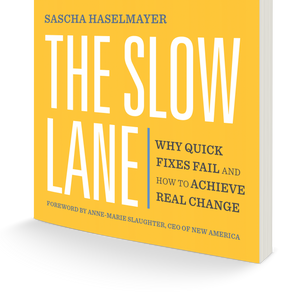A couple of days ago, a group of brilliant people had the following question for me: “Faced with our world’s complex problems, what is the most useful support we can offer people who want to help change things for the better?” I really wanted to impress these guys. My mind went into overdrive. What is the one thing we could do to help? Is it money? Is it technology? Training? Networking? I had seen all those things offered in countless accelerator and incubation programs. My mind kept rattling through options: Design skills? Systemic thinking? Business planning? Leadership skills? My hands were getting clammy.
Oh No.
I was overwhelmed with all these options. Can anyone really master all those skills? In today's world, can only super-humans improve things? We want empathetic entrepreneurial design-thinking system designers versed in innovation methods, participatory co-creation, fundraising, tech strategy, new work, unrestricted fundraising and community organizing. Just writing this makes my head spin.
We want empathetic entrepreneurial design-thinking system designers versed in innovation methods, participatory co-creation, fundraising, tech strategy, new work, unrestricted fundraising and community organizing. Just writing this makes my head spin.
But here I was, still on the spot, racking my brain. My nerves only began to settle when I homed in on a different kind of answer. What I could have really used when I began my own journey to create change: More insights into what real change really is. And people who brought a long view on how they could support my journey.
1/ What Is Real Change?
Let’s start with the first piece, the insight. Inspired by my training in architecture and a world of startups around me, I thought that real change consists of a solution. A design. A fix. That turned out to be partly true in my case: Our new idea did indeed transform public procurement for the better. But I mistook that idea for being the real change, when it was the means to a different end.
I mistook my idea to be the real change, when it turned out to only be the means to an end. A stepping stone.
Our idea, it turned out, was a stepping stone. Like most social innovations. Through our idea, people learned that city procurement, a six trillion dollar industry, could be open, delightful, creative, serving citizens and not the bureaucracy. What we did helped everyone involved unlearn a deeply held belief that things couldn't be any different. That deep change was possible, and not all that hard. This mindset shift, brought about by our innovation, sparked countless other new ideas. Ideas that were quite different from ours, and that continue to transform the way governments around the world deliver public services in transport, education, social care, health, utilities. Our idea is now part of the real change that is now happening every day, like a piece of ancient DNA.
Mistaking our ideas for real change caused a fair amount of confusion and pain for us. For a while, we defined ourselves by having the one and only answer. Anything, short of people doing what we invented, felt like failure. Our team and operations were designed around this singular purpose. The result: We overlooked the underlying mindset shift that our idea was bringing about, and really changing the world. We missed opportunities to share the agency, and celebrate all the other solutions that emerged. The results were still quite wonderful, but as a team, we paid a higher price. Every day, we had to hold the tension between the single-minded focus on our idea, and the real change it brought about. It was more exhausting, and less collaborative, than it could have been.
2/ How To Be A Good Outsider.
Many programs to support social change, in the spirit of sharing best practices, end up adding more complexity. Do we really have to know so much? What I learned in researching The Slow Lane, talking to leaders of highly successful movements, is that they mostly learned on the job. And there is plenty of time for that: After all, the fastest journeys to change play out over decades. Albina Ruiz first spent more than a decade helping waste-pickers in Peru improve their livelihoods. Time needed to stabilize their lives. Which in turn helped them build the confidence that they could make a difference (another decade). And then they went on to imagine (and realize) an audacious vision for change (another twenty years)!
Successful Slow Lane leaders adapt to changing needs, picking up new skills and expertise along the way. And these moments of adaptation are where outside support is needed the most. They can be the most painful parts of the journey. Letting go of ideas is painful. Navigating financials is painful when you change things. Letting go of an organization to make room for something new is painful. Letting go of a role is painful. The pain comes from not recognizing what is going on, and the uncertainty of what comes next. The here and now can be overwhelming, making it hard to do what the Slow Lane teaches us: to hold the urgency, listen, share the agency, nurture curiosity. Help here, in these messy moments, can be transformational. It is also a brilliant moment to invest money, time, and energy, if you know how to make sense of the situation.
Without perspective, these moments of change can look like crisis: things no longer work, cracks start to show. Just like the tension between our idea, and the real change that was happening. Holding the urgency in such a moment can reveal a different truth, that it’s time to adapt to a new game because good things have happened. We need supporters who can see the moment, trust the journey, and stick around for as long as it takes. That's when we can level up, by reframing the mission, or building more bridges for more collective action.
What can this look like in action? I am really inspired by how Thread, the organization co-founded by Sarah Hemminger that supports long-term caring relationships for disadvantaged youth in Baltimore, solves a similar problem: How to support and care for the volunteers, who commit unconditionally to a young person for ten years. Their solution is to add a second line of support, called collaborators, trained to offer perspective, resources, and care for the front-line to get overcome challenging times. (Read more about how Thread works). After all, carers need care, too.
Two things. That's it.
I apologize if all this sounds complicated. It really isn't. Whoever you are, you can support the Slow Lane. Whether you work in government, as a philanthropist, an accelerator, a friend, or family: First, help slowlaners discern what real change means, and that their great idea may just a stepping stone to something bigger. Make that less scary, by talking about the transitions that lie ahead. Then commit to sticking around for as long as it takes. Your role is to be a caring outsider, keeping an eye on te whole journey. Be someone trusted, who can put the steps of the journey in perspective, who is empathetic to the fears of letting go, and who is ready to do what is needed during the messy moments of transition. Free from judgement, not imposing your ideas. To do that, you need to be informed about how Slow Lane change works, how stories play out. And you need to earn the trust, so that slowlaners themselves will be truly open with you.
Really, what you will be all along, is an insider in disguise. Wait. Isn't that what it means to support a loved one?



